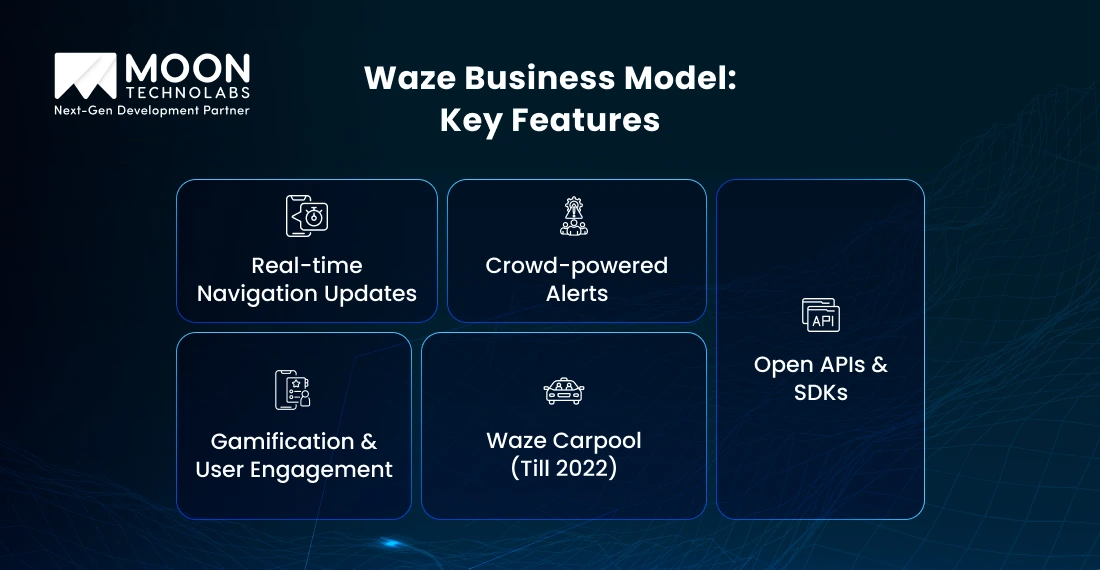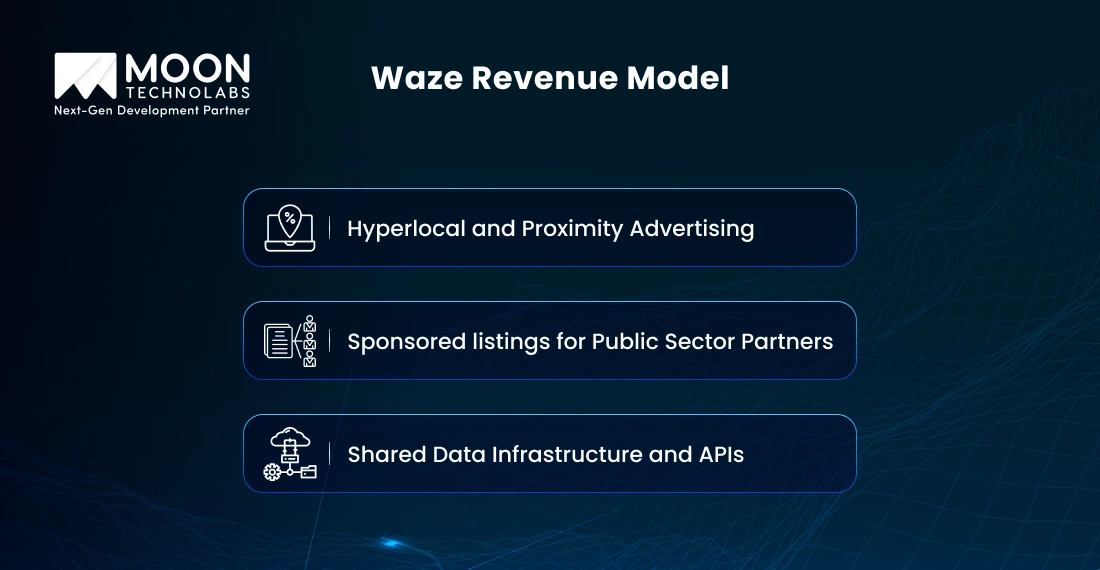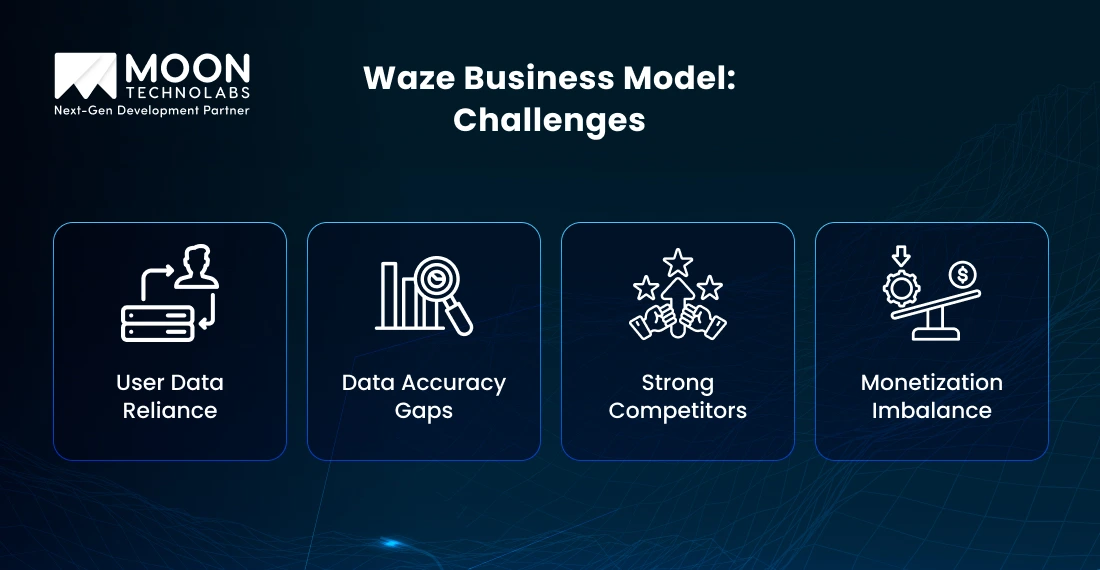Table of Content
Blog Summary:
Moon Technolabs empowers startups and enterprises to replicate the success of the Waze business model. With deep expertise in real-time tracking, crowdsourced data modeling, and context-aware UX, you can build intelligent, location-first platforms like Waze, tailored to your niche. This in-depth blog is your roadmap to launch scalable and monetizable mobility apps for smarter user engagement..
Table of Content
Every minute that users spend commuting and stuck in traffic is an opportunity to guide them on the right route by building a customized path specific to their location data. Waze Maps already turned this into a billion-dollar business before Google acquired it for USD 1.3 billion.
However, when Google integrated Waze into Google Maps, the latter had already garnered over 140 million users worldwide. Waze did this by turning the crowdsourced data into gold and solving major traffic problems by introducing features like Waze Carpool.
The Waze Business Model made people’s lives easier while commuting and also created a revenue stream. They had a solution to a problem that affected a very large community, making this idea a success through a community-driven approach.
What if your business could create a similar navigation platform? This blog dives deep into Waze’s entire business model analysis, guiding startup and SMB owners, business leaders from CMOs to CTOs, and thought leaders.
When Google Maps was launched in 2006, Waze started its journey as FreeMap Israel. However, in 2008, it rebranded and changed its name to Waze. By the end of 2018, it had already reached over 115 million monthly active users.
Waze was launched as the brainchild of three Israeli friends and had about 80 employees. After a couple of funding rounds, Waze started with a vision to revolutionize how people navigate and communicate.
Waze started as an app to fully focus on digitally mapping the Israeli map in the Hebrew language. However, their idea had much more potential when using this technology to address the inefficiencies of traditional navigation systems.
They saw a great opportunity to leverage user-generated data and update drivers’ navigation systems in real time. Instead of using static data provided by GPS systems, Waze utilized real-time traffic updates, crowdsourced reporting, and dynamic rerouting.
This made data more accurate and reliable, and caught the attention of venture capitalists and prominent investors like Horizon Ventures and Kleiner Perkins.
When Waze became available in the US and UK in 2011, 12 broadcast stations partnered with it to include its data in their traffic reports. With its community-driven business model, Waze generated over USD 400 billion in revenue in 2022.
Here are some lessons to learn from the Waze business model:
If you’re solving a real-world, high-frequency problem backed by a community of users, you don’t need massive resources to build something impactful and monetize it.
From data architecture to API integrations, Waze proves how to design for high availability and low latency. It’s a blueprint for leveraging real-time data without expensive infrastructure.
Waze leverages the power of marketing in motion with location-based advertising. It shows how contextual timing and user trust can convert drivers into buyers.
Building a niche app, whether it’s logistics, tourism, ride-hailing, or retail, the fundamentals can be tailored to your vertical with a tailored mobile solution.
Build a map-based app like YourMap to power up location intelligence, real-time routing, and user engagement with the UI/UX designed for scale.
Whether you manage a delivery fleet, own a tourism startup, or even have a delivery service platform, building a custom navigation app can save time in transit. Driven by real-time data, you can build a model similar to Waze and change how transportation works. Here’s how:

Waze is similar to Google Maps, Apple Maps, or any other map navigation app market. However, the one feature that sets it apart is the community-edited maps with voice-enabled navigation for complete accuracy of updates and directions.
Here are some other striking features of the Waze business model:
Waze constantly updates routes based on user-reported events like accidents, roadblocks, or weather conditions, and adapts dynamically. It doesn’t just give directions but also allows users to access real-time information shared by others.
Whether it’s speed traps or potholes, drivers are alerted in real time, thanks to data from fellow users. While driving, Waze users can update the directions by mapping out any accidents, road closures, or roadblocks on the way to help others avoid them.
Waze’s business model uses avatars, levels, badges, and even voice customization to gamify user contributions. Users earn points and rewards for contributing data and reporting incidents. They can redeem these points by participating in virtual meetups with Waze staff and getting Waze swag products.
Waze also experimented with carpooling to optimize unused driving capacity. Though it has been shut down, it offered insights into multi-purpose mobility products.
Waze offers integration options via its SDKs, making it easier for OEMs, smart mobility providers, and third-party services to plug into Waze data or offer Waze within their apps.
Let us turn your location-based app idea into a go-to-market-ready plan with Waze’s precision and strategy.
A Waze-like app can help you overcome route inefficiencies by optimizing real-time deliveries and saving fuel costs with GPS routing. Following a freemium model with B2B monetization layers, here’s how it creates value for its users:
Crowdsourcing is its core engine because it’s driven by the community’s real-time feedback from drivers. Using crowdsourced data makes the app incredibly responsive and context-aware. User-generated content eliminates the need for manual data entry and installing expensive sensors.
For startup owners, this is a great takeaway: users are the product and the producers, and your system can scale without scaling the costs.
Waze uses location-based advertising to promote local businesses, franchises, and chains. Branded pins and pop-ups are displayed en route for drivers. These ads are hyperlocalized and personalized, and only appear contextually when a car is stopped.
For CMOs, Waze provides a great takeaway: personalized advertising is helpful when it is hyper-local, well-timed, and placed for users.
Waze’s business model involves collecting massive amounts of data on traffic patterns and road conditions that are valuable to many third parties. By sharing anonymous data on traffic and road conditions with transport departments and other cities’ local organizations, Waze helps municipalities make informed decisions.
Its feature, Waze for Cities, provides CTOs and CEOs with the best option for using strategic data licensing to turn their custom real-time navigation app into a successful B2B product without compromising on data privacy.
Waze also offers many platform integrations for both the Android and iOS platforms. Android Auto and Apple CarPlay are some of these, which allow users to connect seamlessly with their apps. With this feature, Waze has something to offer CMOs that can help boost user retention, session length, and stickiness.
Waze’s business model is built on advertising, crowdsourced data, and a community of drivers. Its primary customers are individual drivers who look for traffic and navigation updates in real time. Hence, it caters to regular commuters, delivery drivers, and long-distance travelers.
The unique value proposition of this model lies in its ability to gather real-time traffic information and use it to recommend the most efficient routes. By using targeted advertising, customers who are near a store’s location can find a route that’s free of congestion or road closures.

As already mentioned above, geographical locations are the key forces driving Waze advertising. Before Google acquired Waze, it reportedly earned around USD 37.7 million in annual revenue from ads and partnerships and continued to grow under Google.
However, the entire monetization model that generates revenue consists of many other components. Let’s see how it works:
The Waze ads platform allows advertisers to introduce in-app promotions, search ads, and pins. It earns its revenue from hyperlocal advertising. Advertisers pay for impressions, proximity-based engagement, and premium ad placement, which increases attention and reduces distraction.
Waze for Cities is a highly useful initiative with its foundation built on free data-sharing, helping over 1,000 strategic city partnerships. With these, the business model of Waze strengthens its public sector relationships, often leading to strategic partnerships or custom solutions funded through government contracts or grants.
While Waze runs independently, its data helps Google enrich its ads, traffic insights, and navigation. This integration supports indirect revenue through shared infrastructure, user retention, and improved ad targeting.
Data-driven utility plus ecosystem integration provides long-term monetization that scales with user growth.

Even global leaders like Waze face roadblocks—from data dependency to tough competition. But each challenge they encounter offers a blueprint for innovation. Here’s how your product can overcome these pitfalls and gain a competitive edge.
Waze often experiences stability problems, app crashes, and freezes, particularly when integrated with third parties like Apple CarPlay and Android Auto. Such technical instabilities can deter users from relying on Waze.
Tech Tip for Developers: Use hybrid models—pair user input with IoT sensors, traffic APIs, or city data sources to maintain the experience.
The data collection resources and crowdsourcing methods of Waze’s business model can make it less reliable in areas with poor internet connectivity. For example, in rural areas with inconsistent Internet, Waze’s comprehensive offline navigation can affect its usability.
Useful Tip for Founders: Build transparent opt-in flows and include clear value propositions in exchange for data encryption that comply with GDPR and CCPA.
Google Maps and Apple Maps offer more stable experiences with deeper integrations. While Waze uses approximately 0.23 MB per 10 miles compared to 1.33 MB in Apple and 0.67 MB in Google, it can reduce map detailing and functionality.
Helpful Insights for CMOs: To make your app stand out from other navigators, focus on industry-specific use cases like logistics, tourism, and car rentals.
Waze provides less comprehensive information on businesses and locations compared to Google Maps, which offers detailed reviews, photos, and operating hours. While Waze has innovated in contextual advertising, aggressive monetization could damage user trust.
Insightful Strategy for CTOs: Use AI/ML to fine-tune when, where, and how ads appear. Prioritize UX-first monetization with proactive rerouting.
Get a tailored tech stack and monetization plan, and let’s co-create your Waze-style app, complete with launch support.
The Waze business model shows a masterclass in leveraging user behavior, community-led scale, and data monetization. Product strategists, founders, and investors evaluating opportunities in location-based platforms, here’s what they can build:
Building a highly adaptable platform similar to Waze is easier when you have a trusted software development partner. If your product requires spatial behavior, community data, or route intelligence, Moon Technolabs can help you turn proven product models into tailored platforms.
Waze began as a GPS app, built on the idea that drivers could report real-time road data faster and more accurately than legacy systems. Google’s acquisition turned Waze into a consumer product with high retention and a data engine.
In this breakdown, we explored how Waze’s product and business model evolved, what made it defensible and scalable, and how its core mechanisms can be replicated or adapted for other markets.
Ready to build your Waze-like app? Let us build you a tailored plan with the features, monetization paths, and tech stack that fit your business.
01
02
03
04
Submitting the form below will ensure a prompt response from us.